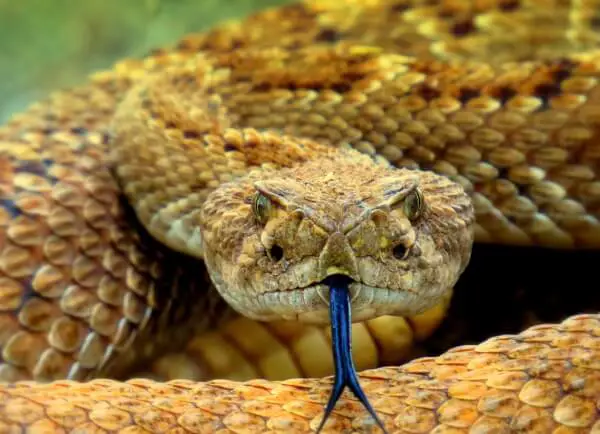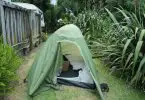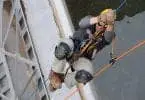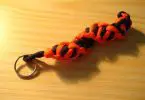There are few things that will ruin a hike more quickly than a snake bite – and unless you’re in Iceland, Ireland, New Zealand, or Antarctica, chances are there are snakes around. While the United States only hosts 21 venomous snakes (“only” is used loosely here), many of them can cause serious damage, especially if left untreated.
In this guide, we’ll go over what you need to know about snake bite first aid – including prevention, snake identification, wound treatment, and evacuation. Next time you go out in the field, be prepared with everything you need to manage your next snake encounter!
An Ounce of Prevention
We know that this article is about snakes, but we just can’t talk about snakes without talking about elephants, first. Well, just the elephant in the room – that is, that most snake bites are completely preventable.
Snakes, like most wild animals, really want nothing to do with humans besides maybe some snacks now and then. In fact, most of the time they’re afraid of us! The easiest way to prevent a snake bite is to simply avoid snakes – chances are, they’re avoiding you, too.
There are a few common ways that snake bites happen, though, so let’s get into those now.
- Problem: But I Didn’t See It! Snakes are sneaky (that’s where the phrase “sneaky snake” comes from”), and one of the most common snake bite scenarios happens when a hiker accidentally steps too close to a snake crossing the trail or sunbathing on a rock. Luckily, these bites can often be avoided!
- Solution: Stay Aware! While rattlesnakes come with a handy built-in warning system for “I’m about to freak out and bite someone,” most snakes don’t. Always scan the trail as you walk for critters – you might also find some cool stuff!
- Problem: Look What I Can Do! The other most common way people get bit is by, well, trying to interact with snakes. Many folks think that they can simply move the offending creature out of the way using a stick or their boot – this is not the case. Many snakes can strike at up to 20 G’s, and even snakes that appear dead can pack a deadly punch.
- Solution: Don’t Touch That! We all get delusions of grandeur sometimes, but believe us, you’re not a snake charmer. Don’t touch the snake. Don’t touch the snake with a stick. Don’t sing to the snake. Don’t try to impress your date with your Steve Irwin impression. Simply give it plenty of room and go around.
Now that we’ve got prevention out of the way, let’s get into the first piece of first aid: snake identification.
Snake ID: What Was That?
Generally in first aid, identifying the thing that caused the injury isn’t ultra-important. With snake bites, however, it can be the difference between life and limb. Unless you’re a bona fide herpetologist, you’re probably not going to be able to identify every species on the spot, but we’ll give you a few tips that can help you determine how to treat the injury, how serious the situation is, and what you need to tell the responders when you get back to town.
Venomous or Not?
The first thing you want to determine in any bite is whether or not the snake is venomous.
There are a few easy rules to follow to make this call:
- Know where you are. Certain venomous snakes live in certain areas. If you’re backpacking in the deserts of Utah, for instance, you’re probably not going to run into a lot of coral snakes. You will, however, probably run into a few rattlesnakes. Check in with a local ranger station or information center to see what kinds of venomous snakes hang out in the area you plan to explore, and learn what they look like.
- Look at the head shape. Most of the venomous snakes in the United States are part of a group called “pit vipers”. These include all the rattlesnakes, cottonmouths, sidewinders, and copperheads. Pit vipers are usually easily identifiable by their diamond shaped head, slanted eyes, and bit pits below their nostrils. If bitten by a snake with these features – chances are you need medical attention.
- Something about Jack? One of the only venomous snakes in the U.S. that isn’t a pit viper is the Eastern coral snake – and unfortunately, it has a completely harmless lookalike that makes it a pain to identify. If you encounter a thin, squiggly thing with bright yellow, red, and black markings, remember this rhyme to determine how bad your situation might get:
Red touch black, you’re okay Jack
Red touch yellow, you’re a dead fellow
A coral snake’s markings will follow a red, yellow, black, yellow pattern – so pay attention.
These tips cover the venomous snakes in the United States – but if you plan to travel outside the U.S., make sure to get informed on identification in your destination.
And Then What?
Okay, so you’ve got the whole snake identification thing down. What do you do with that information? The first thing to remember is that all bites, venomous or not, hurt! Depending on your pain tolerance, mood, and who you’re trying to make an impression on, a minor bite can feel like the end of the world.
However, all bites carry the risk of infection, especially while backpacking or camping. It’s always better safe than sorry – especially if you value keeping all your fingers and toes. When in doubt, hike out. Next, write down all of the markings and features you can remember.
The treatments for snake bites are specially tailored to each species – and the antivenin of one snake won’t work for another. When you get to medical care, make sure to give the responders your list – this will help them narrow down exactly what treatment to use and lessen the risk of serious issues.
Now that we’ve gone over identification and why it’s important, let’s shift gears. This next section gives you a step-by-step guide on what to do between bite and getting back home.
The Good Stuff: First Aid in the Field
All that stuff above was important, but you probably came here for the hands on. Well, the wait is over! This section gives a run down of the steps to take once you or a companion are actually bitten, assuming that the offender is venomous. Before we dive in, let’s take a look at how snake venom works.
Most pit vipers have a type of venom called a “hemotoxin”. Hemotoxins work by destroying red blood cells – that means that blood doesn’t clot right and tissues like muscle and skin can’t get the oxygen they need to stay alive. Bites with this kind of venom are less often fatal, but they can mean losing fingers, toes, or even entire limbs.
Must read: Camping First Aid Kit: Always Be Ready for the Uninvited Guest… Emergencies
Other snakes, like coral snakes, have what’s called “neurotoxins”. These toxins freeze the nervous system and breathing muscles – and can be very deadly. Both types of venom work by spreading through the blood stream.
While the only true treatment for either is antivenin, there are steps you can take to prevent the spread of the venom. That’s why, as you’ll see in the guidelines below, keeping the wound immobile and the victim calm is the most important thing you can do to prevent a situation from going from bad to worse.
And now, without further ado, here is your basic first aid guide for snake bites:
- Make sure the scene is safe. If that snake is still lurking around, relocate to a safe distance away. The only thing worse than a snake bite is two snake bites.
- Keep calm. As mentioned above, venom works by spreading through the blood stream. While keeping calm may be easier said than done, try to keep the heart rate slow. Taking deep breaths and offering calming words can help.
- Clean the wound. Some venom may remain on the skin after a bite, and even if no venom was injected, all bites have a high risk for infection. Clean out the bite with clean water, if available.
- Remove jewelry. Hemotoxins can cause some pretty extreme swelling. Remove any jewelry or restrictive clothing to prevent complications ahead of time.
- Cover the wound. Wrap the wound in a clean dressing. If you don’t have a sterile dressing, use a ripped-up piece of clothing.
- Immobilize the area. If the bite is on a limb (they usually are), splint and immobilize it below the level of the heart. This will prevent excess blood flow and keep the venom limited to the initial site for longer.
- Get to medical care. This is the absolute most important step! Get to a medical professional as quickly as possible. If you have multiple people, carry the victim – the less they walk on their own, the less the venom will spread.
- Mark swelling. As the venom progresses, swelling will, too. With a permanent marker (if you have one), mark the edge of the swelling and the time every 15-20 minutes. This will help doctors assess the severity of the bite.
As if we can’t drill this point home enough – the most important thing you can do to treat a snake bite is to seek professional medical care. Follow these steps to increase your chances of a good outcome.
Before we wrap up, there’s just a few more things to go over – snake bite myths.
Snake Bite Myths: Fact or Fiction?
There are plenty of ailments in this world that can be successfully treated with superstitious home remedies. Snake bites? Not one of them. There are about as many myths on how to deal with a bite as there are actual snake species and some of them do a lot more harm than good.
We’ll go over a few of the major myths in snake bite treatment here, and why you shouldn’t follow them.
Myth #1: Suck Out the Poison!
This is probably the most common myth when it comes to treatment. The belief that you can simply “suck out” the poison is so widely held that many major brands sell vacuum pumps specifically designed for venom extraction. We wish it was that easy.
While you might see some TV survivalists who swear by the venom extraction method, a bunch of scientists have shown that even the expensive pumps do just about… nothing. In fact, they can actually cause more harm to a victim. That’s just insult to injury. Essentially all major medical organizations advise against venom extraction attempts.
Myth #2: Find That Snake!
Many people believe that the only way to properly identify a snake is to kill it and bring it with you. While identifying the snake that bit you can definitely be a big help to healthcare providers, don’t be so hasty to chase after it.
See also: How to Make a Snake Trap: Best Methods for Effective Trapping Action
Most professionals can determine a course of treatment based on the symptoms, the area you were in when bitten, and simple identifying features (like size and markings).
Chasing down, attempting to capture, or attempting to kill a snake are all three things that usually lead to more bites (see that whole section on prevention up above). What’s more, some snakes are protected under federal or state laws, and you can actually be charged for killing them – yikes!
Myth #3: Shock the System!
Now we’re not entirely sure where this idea came from, but it seems that more than a few people think that using jumper cables, tasers, or other methods of electrical shock on a snake bite will neutralize the venom and stop the problem.
We hate to break it to you, but, it won’t. Using any kind of electricity will not stop snake venom from doing its dirty work. What’s more, you run the risk of burns, nerve damage, and dangerous heart rhythms. Sending the heart into overtime is exactly what you want to avoid – so avoid the electricity.
Myth #4: Ice and Knives
These last two tricks both seem to make sense at first glance. It’s a common belief that putting ice on a bite wound will slow down blood flow and prevent the venom from reaching other parts of the body. Blood flows pretty quickly through our bodies, and chances are the venom has already spread well beyond the actual bite.
So, unfortunately, all ice really does is cause even less healthy blood to reach the tissues – which speeds up damage and does more harm than good.
The second “trick” is to cut open the wound. The idea here is that the venom will naturally seep out. Once again, our blood moves pretty quick, and the venom will have already spread far beyond the bite by the time you can bust out that pocket knife. Cutting open a bite leaves you at risk for further infections and does nothing to help envenomation.
Summing Things Up
We’ve given you all you need to know about first aid for snake bite encounters on the trail. We went over some tips for prevention, and a few on identification, too. We gave you a step-by-step guide for how to care for a snake bite victim on the trail while you get to safety, and we went over some of the common myths for bite treatments. For more tips on how to avoid wild animal attack, see our useful piece to help you.
Featured Image Source: https://unsplash.com/photos/f1q4NlVRYSc








